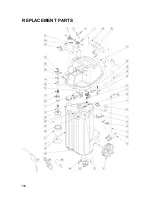
6
• Keep the service hoses away from hot or moving engine parts. Hoses can split or burst
causing fluid to be expelled.
• Avoid contact with engine coolant.
• Treatment methods are as follows:
Eyes: Flush eyes with plenty of water.
Skin: Wash with soap and water.
Inhalation: Move to uncontaminated area.
Ingestion: If large amount, get medical attention.
If any irritation persists, get medical attention.
• Dispose of waste fluid according to environmental laws and regulations.
Fuel, oil vapors, hot steam, hot toxic exhaust gases, pressurized fluid, and other debris can cause
serious injury.
Risk of unexpected vehicle movement.
• Block drive wheels before starting vehicle’s engine to begin an exchange.
• Unless instructed otherwise, set parking brake and put gear selector in park.
• Do not leave a running vehicle unattended.
• If vehicle has an automatic parking brake release, disconnect release mechanism for
testing and reconnect when testing is completed.
A moving vehicle can cause injury.
Risk of entanglement. Engine has moving parts.
• Do not place tools on fenders or other places in engine compartment.
• Keep yourself, clothing, battery cables and service hoses clear of moving parts such as
fan blades, belts, pulleys, hood and doors.
• Barriers are recommended to help identify danger zones in test area.
• Prevent personnel from walking through immediate test area.
Contact with moving parts can cause injury.
Risk of fire or explosion.
• Do not operate in the vicinity of open containers of flammable liquids such as gasoline.
• Keep hoses and jumper cables away from heat sources and sharp edges.
• Do not operate equipment with damaged cords or hoses until they have been examined
by a qualified serviceman.
Fire or explosion can cause injury.
Summary of Contents for EW30001
Page 11: ...10 MACHINE OVERVIEW...
Page 17: ...16 REPLACEMENT PARTS...





































